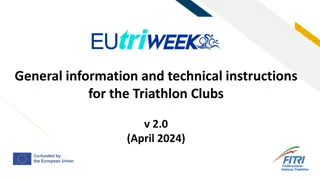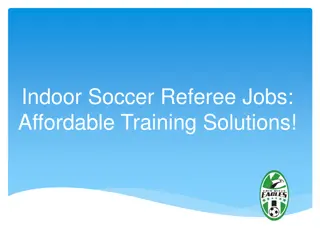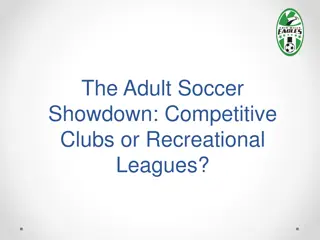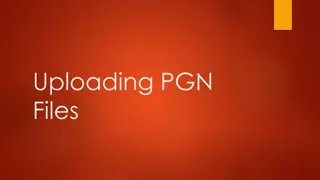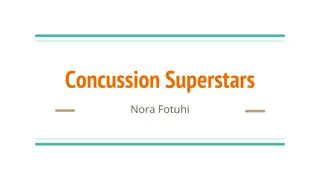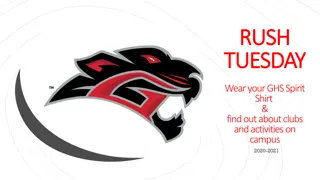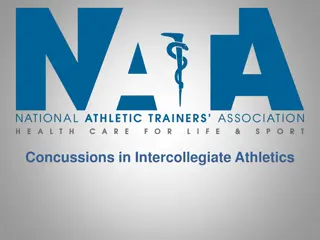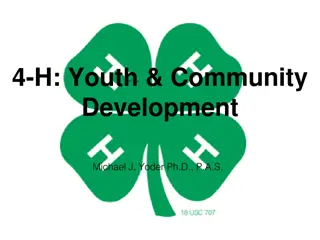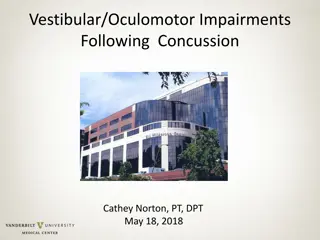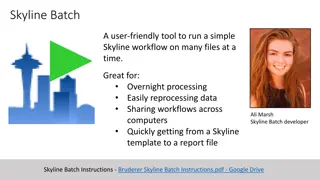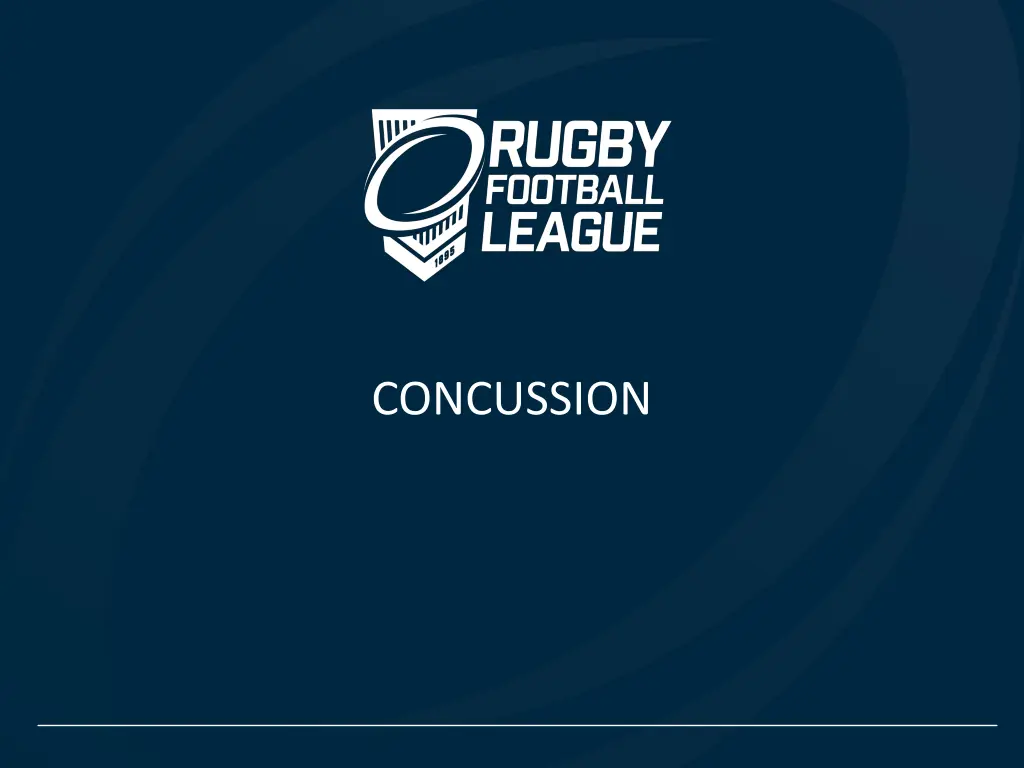
Understanding Concussion: Causes, Recognition, and Care
Learn about concussion, a brain injury caused by a direct or indirect blow to the head, its signs and symptoms, the importance of recognizing and properly treating concussions, and the duty of care in sports and community settings. Understand the potential risks, including structural brain injuries, associated with concussions and the long-term impact on brain health.
Download Presentation

Please find below an Image/Link to download the presentation.
The content on the website is provided AS IS for your information and personal use only. It may not be sold, licensed, or shared on other websites without obtaining consent from the author. If you encounter any issues during the download, it is possible that the publisher has removed the file from their server.
You are allowed to download the files provided on this website for personal or commercial use, subject to the condition that they are used lawfully. All files are the property of their respective owners.
The content on the website is provided AS IS for your information and personal use only. It may not be sold, licensed, or shared on other websites without obtaining consent from the author.
E N D
Presentation Transcript
WHAT IS CONCUSSION? Concussion is caused by a direct or indirect blow to the head, face, neck causing the brain to be shaken inside the skull May be indirect - whiplash Concussion leads to a temporary impairment of the brain s function If not treated properly can lead to permanent damage In rare cases can be fatal It is possible that repeated concussions lead to CTE &/or Alzheimer s Concussion
DUTY OF CARE Doing the right thing for your players Long term health Professional sport is more likely to be sued But Community Clubs have the same Duty of Care to participants & the same legal responsibility Insurers want to know that polices being followed Premiums going up or unattainable Concussion
HOW TO RECOGNISE CONCUSSION Difficult to recognise even for trained medical staff Coaches & first aiders must assume that where a player has had a bang to the head that the player is concussed. A player does not need to be knocked out (lose consciousness) to have a concussion. Less than 15% of concussion cases involve a player being knocked out. Concussion
SIGNS & SYMPTOMS Doesn t know the venue, last scorer, opposing team or the score Shows signs of confusion Can t remember what happened before &/or after the injury Delayed response to commands Not playing as well as expected Has been knocked out Headache/localised pain A fit or convulsion Dizziness/light- headedness/dazed expression Concussion Unsteady on feet/loss of balance/uncoordinated movement A blank stare/glassy eyed Loss of vision, seeing double or blurred vision, seeing stars or flashing lights Ringing in the ears Tonic posturing Nausea and/or vomiting Slurring of speech Poor concentration Strange or inappropriate emotions (laughing, crying, getting angry easily) Generally feeling unwell
STRUCTURAL BRAIN INJURIES A player who has had a bang to the head may have structural brain injuries such bleeding or swelling inside the brain May well be invisible but can be fatal Lucid interval/delayed onset If a player has any of the following symptoms they should be referred to a hospital immediately Must be accompanied by a responsible adult. If in doubt call an ambulance. Speed is important Concussion
SYMPTOMS STRUCTURAL INJURY A headache that is getting worse Vomiting or prolonged nausea Drowsiness or can t be woken or develops slow or noisy breathing Slurred speech or difficulty in speaking or understanding Abnormal behaviour/restlessness/irritability/aggression Weakness, numbness Decreases in coordination and/or balance Increased confusion Loss of consciousness A fit or convulsions (arms & legs jerking uncontrollably) Acutely painful/stiff neck which increases in severity Sensitivity to light and/or noise Blurred or double vision or pupils which vary in size Clear fluid coming out of ears or nose Deafness in one or both ears
IF CONCUSSION IS SUSPECTED Continuing to play increases the player s risk of more severe, longer lasting concussion symptoms as well as increasing their risk of other injury: Remove the player from play immediately Do not let them return to play that day Don t leave them on their own Make sure they see a doctor or go to an A&E department Make sure parent/family/partner know Don t let them drive Concussion
MATCH OFFICIALS Club s responsibility to identify possible concussion Match Official can stop game & call first aider on if concerned about a player Can advise on what they saw Can hold up play if player won t leave pitch Match officials will report any issues Concussion
TREATMENT FOR CONCUSSION Rest is most important Not just physical rest but also mental rest avoid computers, smart phones, game consoles, reading etc. Once the player is completely symptom free and cleared to do so by a medical practitioner (player s responsibility) Then player can begin to take part in physical exercise again in a Graduated Return to Play (GRTP). Concussion
GRADUATED RETURN TO PLAY - ADULT Concussion
GRADUATED RETURN TO PLAY U19 Concussion
PREVENTION Concussion is often caused by accident Coaches to encourage playing within the rules Coaches discourage high tackles, dangerous throws, shoulder charges and spear tackles Tackling technique is important as players can be concussed by contact with the ball carrier or head clash with team mate Playing surface is not too hard (frost or drought) No dangerous structures such as unpadded posts or fences close to the pitch. Concussion
ADDITIONAL VULNERABILITY W&G Research indicates W&G have higher concussion rates Age 18 & under more susceptible, worse symptoms, longer recovery History previous concussions increase risk of more & increase recovery time Concussion
HEAD GUARDS Should all players wear head guards? Soft head guards do not prevent brain injury or concussion (as opposed to superficial cuts/cauliflower ears etc) Phenomenon of risk compensation Encouraging helmet use in players may paradoxically increase the head injury rates The RFL does not support the mandatory wearing of protective head guards in Rugby League Concussion
CLUB RESPONSIBILITIES Make sure all coaches & players are aware & comply First Aiders qualified & understand Parents understand Rules for children applied Report issues to League Concussion
REMEMBER Recognise Remove Recover Return If in doubt, sit them out http://www.rugby-league.com/the_rfl/concussion Concussion



